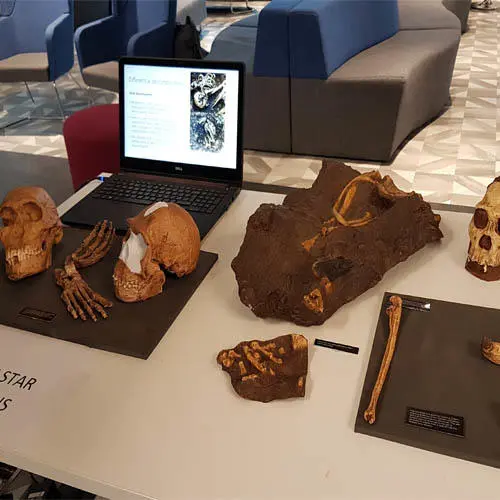UCLan brings world-leading experts together for unique conference
The University of Central Lancashire (UCLan) hosted an unusual and somewhat macabre symposium as it looked at the science of death and burial.
TAPHOS-NOMOS featured some of the world’s leading scientists in the field of taphonomy, which looks at what happens to organisms after they die. This meeting brought together for the first-time specialists working at very different timescales in palaeontology, archaeology and forensic science – from the origins of vertebrates in deep geological time, through to recent mass fatalities and homicide cases.
Dr Patrick Randolph-Quinney, Reader in Biological and Forensic Anthropology at UCLan, organised the symposium. He said: “Taphonomy is quite literally the science of death. It brings together biology, physics and chemistry to understand what happens to organisms after they die, and how soft tissues or bones are preserved. We may learn about how an organism died, and what processes have operated on a body after its death.
“Taphonomy is often translated as the ‘laws of burial’, but it really deals with the things that happen around death, how bodies decompose, and the myriad of processes which can impact that body from putrefaction, decomposition, through to skeletisation - and if we are very lucky fossilization.”
The symposium featured talks from some of the world’s leading experts in the science of death. This included Professor Pat Shipman from Penn State University, who is an expert in the taphonomy of human origins. Her research focuses on the reconstruction of the ecology of ancient environments from preserved fossils, and how we can determine whether fossils in an assemblage are the remains of the activities of early human ancestors or not. She pioneered the use of scanning electron microscopy in diagnosing cutmarks on archaeological or fossil bones.
Professor Shipman’s research has involved fossil and archaeological bone assemblages from Kenya, Tanzania, Ethiopia, Italy, France, Indonesia, and various sites in North and South America. She was part of the team that established convincing proof of cannibalism in Neolithic France and also identified the earliest known bone tools in the world.
"Taphonomy is quite literally the science of death. It brings together biology, physics and chemistry to understand what happens to organisms after they die, and how soft tissues or bones are preserved."
Professor Sarah Gabbott from Leicester University discussed how taphonomy allows us to understand the evolution, history and geological record of life on our planet. She studies so-called exceptionally preserved fossils, where remarkably the organic features of animals, which usually perish rapidly after death, have been transformed through a variety of processes to become fossils, faithfully recording long-extinct animal anatomy.
She said: “From these fossils we can gain a much more detailed and comprehensive picture of ancient life, but first we must ‘read’ them correctly, which is where taphonomy comes in. Only by understanding how this ancient life decomposed and what parts of anatomy preserve, or conversely, are lost, can we understand whether our interpretation of the fossil record and the family tree of life is correct.”
Other speakers included Mike Groen from the Netherlands Forensic Institute. Mike is one of the most experienced forensic archaeologists in Europe and has been instrumental in the setting up of the ARISTA taphonomic facility in Amsterdam, Europe’s first human ‘body farm’, or forensic cemetery to use its official name. His talk discussed why taphonomy is so important to the police and criminal justice system, but only if the science behind it is robust, experiments are well-designed and tested, and data is statistically meaningful.
UCLan is arguably one of the world’s leading centres for taphonomic research, and the School of Forensic and Applied Sciences at the University runs the largest decomposition facility (body farm) in Europe. Its staff are practitioners and researchers in forensic anthropology, entomology, archaeology and biochemistry. Established in 2009, this facility (known as TRACES) uses pig bodies in order to understand the process and timing of decomposition on the ground surface and in burials, what biochemicals produced during decomposition, how insects interact with bodies, and the effects of trauma and burning on the body. This information can be used to both find buried remains, as well as assist the police in criminal investigations.
Dr Randolph-Quinney added: “This symposium really showed us how important taphonomy is across so many sciences – from palaeontology to archaeology to forensics. We welcomed researchers from the US, South America, Europe, Asia and Africa – who might work on different timescales, but who are bound together by a common thread.
“We have seen fantastic interdisciplinary collaborations taking place, with UCLan to lead on creating both an international association of taphonomy as well as journal dedicated to taphonomy across all the timescales. We can’t wait to welcome people back for the next TAPHOS-NOMOS in 2020.”


